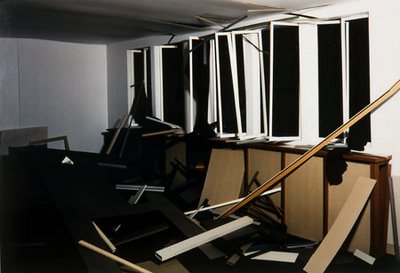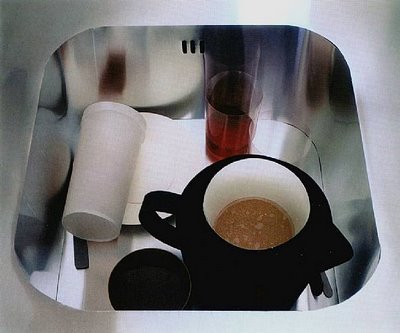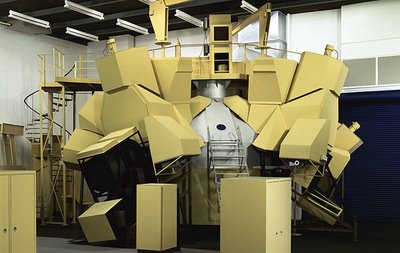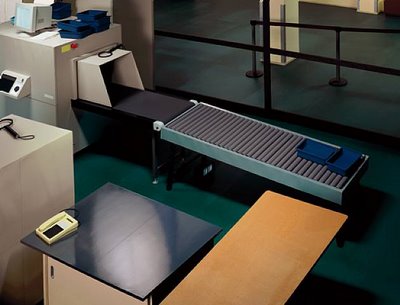
Art in America, June 2005 by Pepe Karmel
A few years ago, my son and I took the shuttle bus from Orlando to Disneyworld. As we drove through the flat Florida landscape, I noticed that the woman sitting next to me was wearing the ID tag of a Disney employee. She was from southern Germany, it turned out, and worked in the Bavarian beer garden at Epcot Center. Wasn't it strange, I asked her, to work in a replica of the place she came from? "The town I grew up in was bombed during the war, and then rebuilt to look exactly the same as it did before," she said. "So it isn't really that different."
Like the German pavilion at Epcot Center, Thomas Demand's photographs offer a cleaner, heater version of the real world. At first glance, they appear to be straightforward records of unremarkable locations: offices, auditoriums, hallways, kitchens, bathrooms, staircases, stadiums and gardens, the familiar sites of mass society. It seems mildly perverse to give modest documents such heroic presentation: enlarged to mural scale and laminated to gleaming sheets of Plexiglas. And there is something off about the scenes in Demand's photographs. They record the traces of human activity, but no people appear in them. The surfaces are too smooth, the edges too sharp. Sometimes things are damaged, but they never betray the wear-and-tear of daily life. To walk through the retrospective of Demand's (mostly very large) photographs (1993-2004) at the Museum of Modern Art was to enter an unsettling alternate universe.
Like Epcot Center, everything in Demand's work is a fake, a meticulously constructed replica in paper and cardboard. Unlike Epcot Center, Demand's pictures often lead the viewer into a troubling confrontation with history, both German and international. A 1994 photograph with the anodyne title Room shows a conference room in a shambles: table collapsed, windows askew, moldings tumbled to the floor, chairs overturned. This is Demand's re-creation of the military conference room where Count Stauffenberg attempted to assassinate Adolf Hitler on July 20, 1944. Four people were killed and the room was demolished, but Hitler survived.

Room, 1994

"Tunnel"- stills from a video, a recreation of the scene of Princess Diana's death

Sink, 1997

Space Simulator, 2003

Archive, 1995

Gate, 2004

15 comments:
I don't know why, but these images are slightyly disturbing for me to look at. However, I do think that Mr. Karmel explains it when he mentions that there are no people in them. The photographs depict something we hardly ever see which are scenes from everyday life where there should be lots of hustle and bustle, but there is none. It seems as if the world is dead, or time is at a standstill. These images just seem to have a mildly discomforting aspect to them.
Another thing too, is that they feel phony due to the absence of people, moreso to me than anything at Disneyworld. I suppose that replications of other worlds from Disney would feel fake as well, but the addition of people brings those worlds to life. Those kinds of things aren't something we see everyday, like Bavaria, or a big silver shiny ball, so somehow they don't seem as false to me as Demand's photographs do. It's really hard to put into words. The Gate photo for example. Even if the airport security gate photo was a set up image, say for a brochure or website, I would still expect to see people in it. Passengers loading their belongings onto the x-ray conveyor belt, going through the metal detector, security staff ushering them along. They're not there. I think these images challenge our views and perceptions of the world, and it's difficult, at least for me, to have to imagine the world without people in it.
It is also interesting to see how photography can be used to teach us about the past and look into previous events in our history. Photography really can do just about anything any other mediums of art and expression could do, and this further proves that. No longer are books, print, television, paintings, etc. the only way to delve into the past and learn about our history. Now we have photography to do that as well. Even though history has already been documented through the camera lens, it hasn't been done so in this way. Photojournalism has only been around as long as the camera has, and not even that long, but now we know it is possible to recreate accurate and detailed scenes of times long gone and can record them for future generations on film. I'm thinking mostly of Room when speaking about this, and I wonder what the image would look like with people in it. I know it wouldn't have the same effect on me, but I will never know how that would be different with people in it. Another thing is that I would be interested to see more photographs such as Room of famous historic scenes with no people in them. Would a photograph depicting people dying in third world countries have the same effect if there were no people in it? How would a photograph of a set-up battle from the Civil War make you feel with no wounded soldiers laying on the ground? It's that sense of the wrong and unnatural that attracts people, so it would be neat to see visualised and further explored someday and see how it affects our ways of looking at the past.
One final thing, is I think it was smart of Demand do present the photographs the way he did in a large format. It would get the viewer's attention no doubt, and gives the purpose of the images more prominence. The viewer realises these images are important and should be thought about and paid special attention to.
I agree with holly, the pictures dont seem realistic to us because of our expectations.
Especially in the Gate photo, there is even a bag on the conveyer belt... but no one is there, it seems abandoned as most of his pictures are.
It was mentioned here and also in the book, that he built scaled down versions of the real thing, so even if he wanted to illiminate the doubt of his viewers that what they are looking at is real by adding people, he wouldnt be able to. he would have to change his entire process, and i believe it is his process that makes these photos unique.
When i look at a photo that challenges my expectations, i walk away feeling that i learned something new, that im taking something of the photo home with me. yAy thought provoking works of art~
Well, by purely looking at these photographs at a glance, I couldn't figure out what's the point of them. If there is a story to tell, then what is it? There is no human except objects and scenes. However, when exam these photos closely, I've notice some unrealistic objects which are duplications of the original ones. To this discovery, it suddenly interests me -- the whole scene is set up by the artist, nothing in the picture is real. Almost immediately, I start to wonder why someone would spend all their time to build replications for a photo shoot.
I think the use of replication is a very creative way of photographing. It saves our time for looking for the right location and object. And everything can be build with low-cost cardboard and paper. This is very close to making movies, when the right scene cannot be locate; the background setting can be totally artificial. But this cannot justify why Mr. Demand uses such technique, as we can see in some of his photographs, the scene is not hard to find at all, they are kitchens, offices. So there must be a better explanation for it. That would be a total control of every object's appearances in the photograph. To do so, Mr. Demand needs to manipulate the scale and the look of these objects carefully. Photographers can communicate more efficiently with viewers this way than merely shooting at a real scene. For example, if a photographer enlarges the scale of an object on a table to an unbelievable size as it presents in a photograph, then there is must be something special about this particular object which the artist wants to tell the viewers about. The viewers then start to looking for the reason for such enlargement and therefore interacting with the work. On the contrary, when shooting an original realistic scene, photographers will not be able to control such property of the subject and therefore must find other ways to express their feelings.
Now back to my first question -- do these kinds of photographs tell stories? The answer is yes. Of course it’s not explicit, but implicit. Looking at the pictures, there is no human presence and therefore no event. However, it makes the viewers wonder that maybe the action is already over and it only shows us the end, the effect of all events that have been taken place in the photograph. Viewer have to integrates their past experience and knowledge to relate such scene to a human event that could happen. When look at "Room" without reading the description, we know that something terrible happened, may be a gun fight or bombing or something else. Now the viewers can complete the story that the photograph is trying to tell.
Both replications and story-telling enable the viewers to deeply interact with the art pieces, and therefore successfully and efficiently create a communication between photographers and viewers.
By viewing all the pictures is shows creativity and imagination. The creator did a good job by creating a replica by showing the viewers what his version look like, so the viewer can understand what he is showing. It is not the original but at least it shows the scene with the artist's point of view. He could manupulate the scale and color of the recreated scene so to emphisize the object that he feels important. This way, the photographer will kind of control the viewer's interpertation of the scene that might be different than the original one.
I don't think the image would carry the same weight if anything was changed. as they are, they are very interesting, kinda like a dream...maybe a nightmare.
The pictures have us(the viewer) completley stumped. with no recognizable (human) figure to help give any clue as to what is going on in the picture, we are left to experience it all on our own.
I think these pictures are disturbing because of the fakeness of them. It removes all of the emotion, meaning, action, and purpose from the original scene and leaves us with a new perspective. One that is just the objects we see telling us a story of what the world is without the choas of humans. A world that maybe perfect or very wrong because it has no life.
I think we can all agree these pictures seem kind of eerie. They are models of spaces as they were before the spaces were destroyed by people. It almost feels as if you are looking at an obituary for places, the last known appearance of a space before it is destroyed. There is a sense of history behind each picture, that background is what gives these images any value. The lack of human figures is being too overly analyzed; these are small replications, there is no way the artist could have added a realistic person(s) in their work.
Danish-
I just wanted to say that I think the idea of Demand's work being an "obituary for places" is fantastic. That's a very poetic way of explaining what he does. They are like a memorial, a re-creation for the purpose of re-examining your own ideas and assumptions about places like this.
Hey everyone,
here is my blog email if anyone wants to answer or comment on Takashi Homma Picture I have comment on this picture.
juniordragon.blogspot.com
The images are easily recognized as a sink, a road, a security gate, but as they lack details that are expected or people, something in the back of the viewer's mind doesn't like them, and they have a sense something is wrong.
I don't think its because the scene is artificial, with that in mind. As Disney displays are obviously artificial, but not disturbing, for example. Its because the images are on the cusp of reading as real. In robotics, they call it Uncanny Valley: as things become more and more human-like, they go through a period which they are deeply disturbing right before becoming fully 'human.' (http://en.wikipedia.org/wiki/Uncanny_valley) The theory has become expanded to cover other things, as it explains some of how humans react to the familiar when its just a little 'off.'
I find this work very intriguing in the sense that Demand's curiosity of how a replica of something would be perceived in the mind of a viewer. The scenes he recreated give off a sense of emptiness and provoke the viewer into wondering why there are no people in the images, to only be later realized that it is really a fake reality. I believe Demand was striving for that effect of human questioning of a 'fake versus real' situation as he was creating these images.
When I first saw these pictures, my first thought was "wow, who died?". Each photo was so silent, so still, and so void of any life that they give the viewer a very eery feeling.
However, the photos look a bit too 'set up' to really portray history accurately. Everything really is too crisp and new and looks more like a messy storage room that someone is still working on.
For me the pictures are a bit surreal. (I think they're meant to be...) I noticed it the most in "Gate." I like them because they are very inventive. Were they just pictures of a room, I would not be as interested. However, these pictures are not ones I would hang in my own house because I find them to have a relatively boring subject matter and presentation.
It seems to me that Hunter present contemporary reworking of Victorian painting. I can't believe how Hunter would use live people to imitate a historical painting back in our times. It is very amazing when a historical motifs are used in a contemporary photographic subject this way. they act like symbolism of culture with other times in history. I feel like I am taking art history all over again. I am actually learning more than just what I learned in art history.
I really do enjoy the way each photo depicts the way the object make a certain shape. It was like art in motion almost. The picture of the boxes that seem like they were falling actually looked like they were gonna fall. It's like catching the last seconds before the result of the action.
Post a Comment